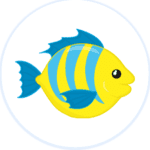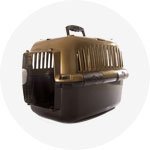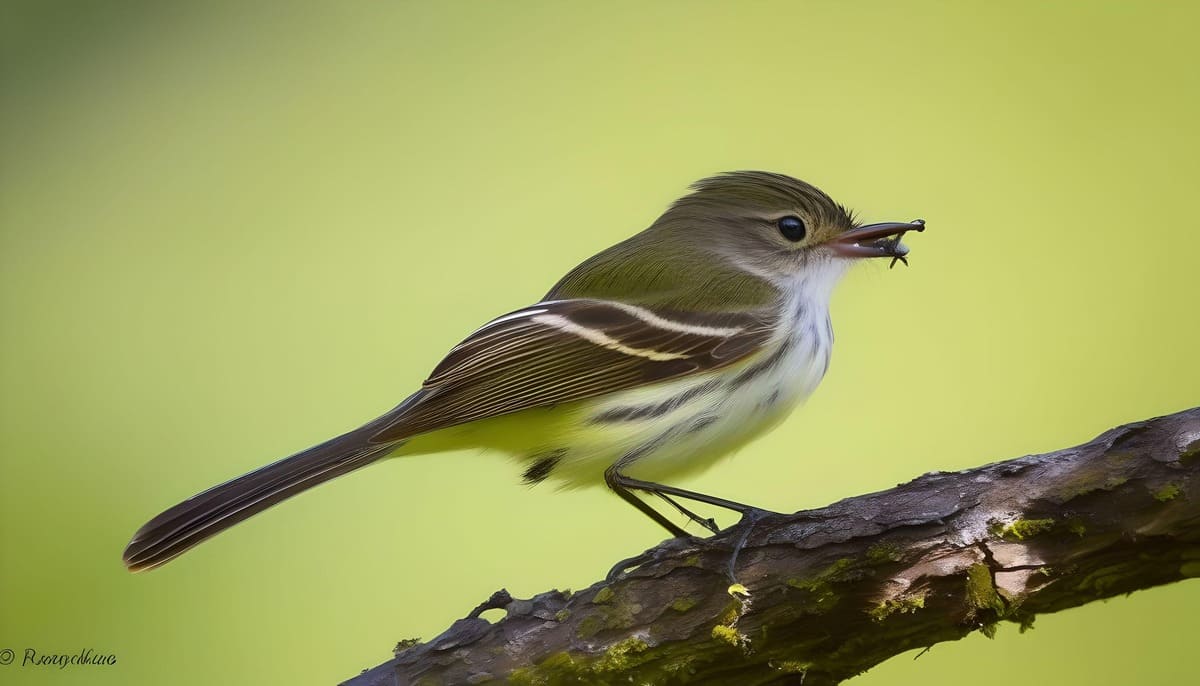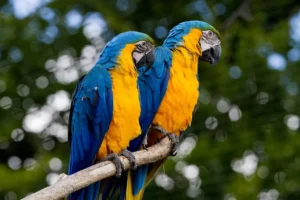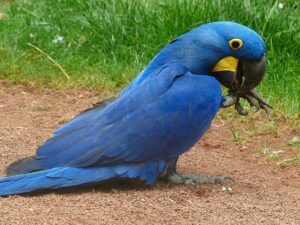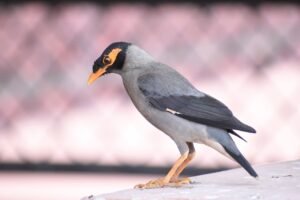Acadian Flycatcher | Habitat, 12 Facts, Conservation, Care, Diet, Health Issues
🌿 Meet the Acadian Flycatcher! 🐦 A petite marvel of the forest, this songbird dons a vibrant olive-green ensemble and serenades the woods with its melodious calls. 🍃 Join us on a journey to discover the secrets of the Acadian Flycatcher, from its intricate nest-building skills to its role as a guardian of the ecosystem. 🌳 Explore the beauty of nature intertwined with the challenges it faces, and let’s unravel the tale of this enchanting bird together! 🌟 #AcadianFlycatcher #NatureMarvels 🦋✨
Acadian Flycatcher
The enchanting world of avian wonders introduces us to the Acadian Flycatcher (Empidonax virescens), a delightful songbird that graces the woodlands of North America. This unassuming yet captivating creature belongs to the tyrant flycatcher family and is celebrated for its sweet, melodious calls that echo through the forest.
Habitat and Distribution:
The Acadian Flycatcher is a master of the treetops, favoring deciduous forests and wooded areas with a dense canopy. Its preferred habitat spans from the southeastern United States up to the Great Lakes, creating a melodious presence in states like Mississippi, Ohio, and parts of the Eastern United States. As a neotropical migrant, these feathered songsters embark on an incredible journey, flying thousands of miles to Central America during the winter months.
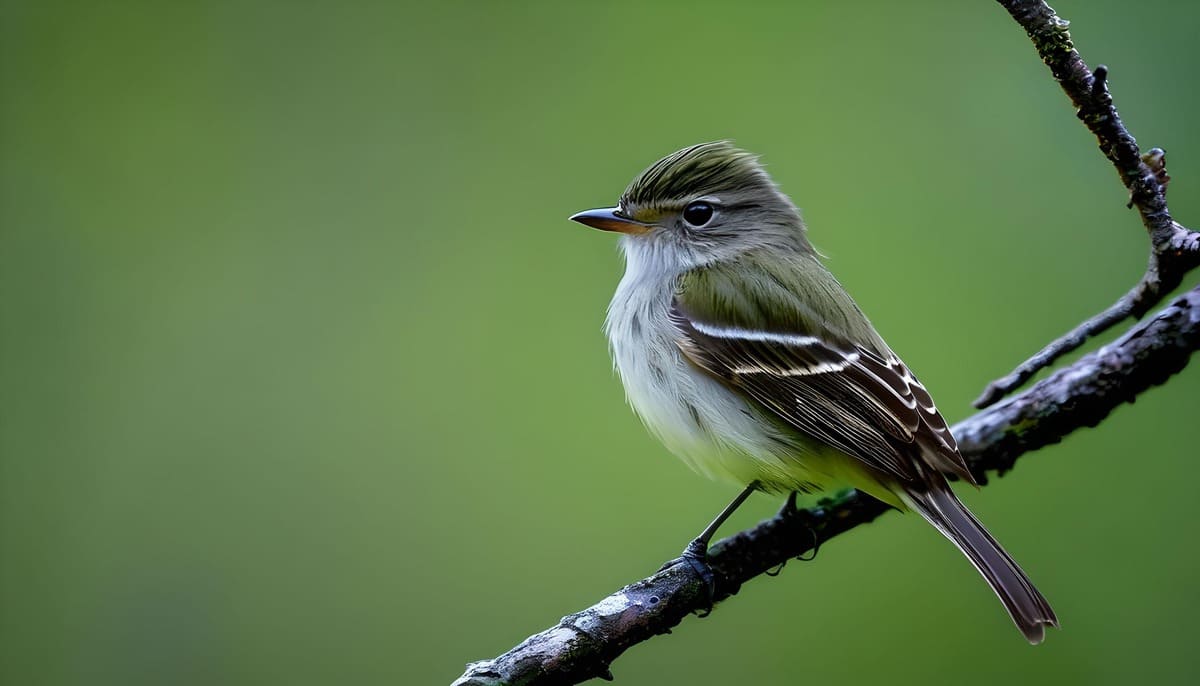
Identification:
Identifying the Acadian Flycatcher is a rewarding challenge for birdwatchers. This petite songbird measures around 5 to 6 inches in length and boasts an olive-green plumage that camouflages perfectly with the lush foliage. Its distinct eyering and slightly hooked bill set it apart, making it a joy for bird enthusiasts to spot among the leaves.
Song and Communication:
One cannot truly appreciate the Acadian Flycatcher without acknowledging its melodious prowess. With a distinctive “peet-sah” or “peet-see” call, this avian virtuoso announces its presence. The intricate songs serve not only as a means of communication but also play a vital role in courtship and territorial defense, creating a symphony that resonates through the woodland realm.
Nesting and Reproduction:
Come spring, the Acadian Flycatcher engages in the delicate art of nest-building. Constructed with finesse, the cup-shaped nest is carefully nestled in the vertical forks of tree branches. The female lays a clutch of 2-4 eggs, and both parents diligently take turns incubating the eggs and caring for the chicks upon hatching. Their commitment to parenting showcases the profound familial bonds within the avian world.

Conservation Status:
While the Acadian Flycatcher is not currently listed as a threatened species, its population faces challenges. The preservation of its preferred woodland habitats is crucial to sustaining healthy populations. Conservation efforts, including habitat protection and raising awareness about the importance of preserving these ecosystems, play a vital role in ensuring the continued well-being of this charming species.
Characteristics and Overview of Acadian Flycatcher
Here’s an overview of the Acadian Flycatcher:
| Characteristic | Description |
|---|---|
| Scientific Name | Empidonax virescens |
| Size | Approximately 5 to 6 inches in length |
| Plumage | Olive-green, blending seamlessly with the forest foliage |
| Distinct Features | Eyering and slightly hooked bill |
| Habitat | Deciduous forests, wooded areas with a dense canopy |
| Distribution | Southeastern United States, Great Lakes region, migrating to Central America during winter |
| Song | Distinctive “peet-sah” or “peet-see” call; a melodious symphony echoing through the forest |
| Nesting | Cup-shaped nests placed in the vertical forks of tree branches |
| Reproduction | Clutch size of 2-4 eggs; both parents involved in incubation and chick care |
| Conservation Status | Not currently listed as threatened; habitat preservation crucial for sustaining populations |
| Role in Ecosystem | Plays a vital role in insect control, maintaining a balance in the forest ecosystem; contributes to the biodiversity of avian species in woodland habitats |
| Notable Behavior | Migrates thousands of miles during winter; intricate and committed parenting behavior |
| Conservation Measures | Habitat protection, raising awareness about the importance of preserving woodland ecosystems |
| Symbolism | Emblematic of nature’s beauty; a joy for birdwatchers and nature enthusiasts |
Acadian Flycatcher Geographic Range
The Acadian Flycatcher, scientifically known as Empidonax virescens, has a diverse and expansive geographic range. These charming songbirds are primarily found in North America, specifically inhabiting deciduous forests and wooded areas. Their range spans from the southeastern United States, covering states like Mississippi and extending up to the Great Lakes region. During the winter months, these neotropical migrants undertake an impressive journey, flying thousands of miles to Central America.
Origin, Evolution and History of Acadian Flycatcher
The origin, evolution, and history of the Acadian Flycatcher trace back to its emergence as a distinct species within the evolutionary timeline of songbirds. As a member of the tyrant flycatcher family, the Flycatcher has evolved specific characteristics and behaviors that contribute to its survival in the wooded habitats of North America. The bird’s history intertwines with the ecological changes of its habitat and showcases its adaptation to diverse environments over time.
Anatomy of Acadian Flycatchers
The anatomy of the Acadian Flycatcher reflects its adaptability to an arboreal lifestyle. These birds typically measure around 5 to 6 inches in length and are characterized by an olive-green plumage that provides excellent camouflage in their forested habitats. Distinct features include an eyering and a slightly hooked bill, which aid in their foraging activities. Understanding the intricacies of their anatomy provides insights into their ecological niche and survival strategies.
Appearance of Acadian Flycatchers
The appearance of Acadian Flycatchers is marked by a subtle yet distinctive beauty. With their olive-green plumage seamlessly blending into the forest foliage, these songbirds are often a challenge to spot. Their modest size, eyering, and slightly hooked bill contribute to their overall appearance, making them a delightful sight for birdwatchers who appreciate the subtle elegance of nature.
Temperament of Acadian Flycatcher
The temperament of the Acadian Flycatcher is characterized by a combination of territorial behavior and a charming singing disposition. While these birds may be elusive in their wooded habitats, their melodious calls, such as the “peet-sah” or “peet-see,” showcase a more expressive and communicative side. Understanding their temperament sheds light on their role in the ecosystem and their interactions within their avian community.
Behavior and Lifestyle of Acadian Flycatcher
The behavior and lifestyle of the Acadian Flycatcher are intricately tied to its forested habitat. These birds are skilled insect hunters, employing a sit-and-wait strategy to capture their prey. Their migratory behavior during winter months underscores their adaptability and resilience. Studying their behavior and lifestyle offers valuable insights into their ecological role and the challenges they face throughout their annual life cycle.

Habitat and Distribution
The Acadian Flycatcher’s habitat and distribution are key aspects of its ecological niche. Preferring deciduous forests with a dense canopy, these birds are commonly found in the southeastern United States and the Great Lakes region. Their distribution extends into Central America during the winter, highlighting the dynamic nature of their habitat requirements and migration patterns.
Social Structure
The social structure of Acadian Flycatchers revolves around their breeding and nesting activities. While they may appear solitary during certain periods, these birds engage in mate selection, courtship, and shared parenting responsibilities during the breeding season. Understanding their social dynamics contributes to a holistic view of their lives within the forest ecosystem.
Acadian Flycatcher Nest
The Acadian Flycatcher nest is a marvel of avian engineering. These cup-shaped nests are meticulously constructed and placed in the vertical forks of tree branches. The female lays a clutch of 2-4 eggs, and both parents actively participate in incubation and caring for the chicks. Exploring the intricacies of their nest-building behavior provides valuable insights into their reproductive strategies and family dynamics.
Acadian Flycatchers Traits
The Acadian Flycatcher exhibits distinctive traits that contribute to its survival and role in its ecosystem. These traits include its olive-green plumage for camouflage, a slightly hooked bill for efficient insect catching, and a melodious vocalization that aids in communication and territorial defense.
Distribution and Habitat of Acadian Flycatcher
The Acadian Flycatcher’s distribution spans deciduous forests in the southeastern United States and the Great Lakes region. Its habitat preference for dense canopies and wooded areas reflects its adaptation to an arboreal lifestyle, where it forages for insects among the treetops.
Reproduction and Life Cycles of Acadian Flycatcher
The reproduction and life cycles of Flycatchers involve intricate behaviors such as nest-building, egg-laying, and shared parenting responsibilities. Understanding their breeding habits provides insights into their resilience and adaptation to seasonal changes.
Communication, Vocalizations and Perception of Acadian Flycatcher
Communication plays a crucial role in the life of the Acadian Flycatcher. Through distinctive vocalizations like the “peet-sah” or “peet-see” calls, these birds communicate with mates, establish territory, and convey other important messages. Their perception of the environment is finely tuned, allowing them to thrive in their wooded habitats.
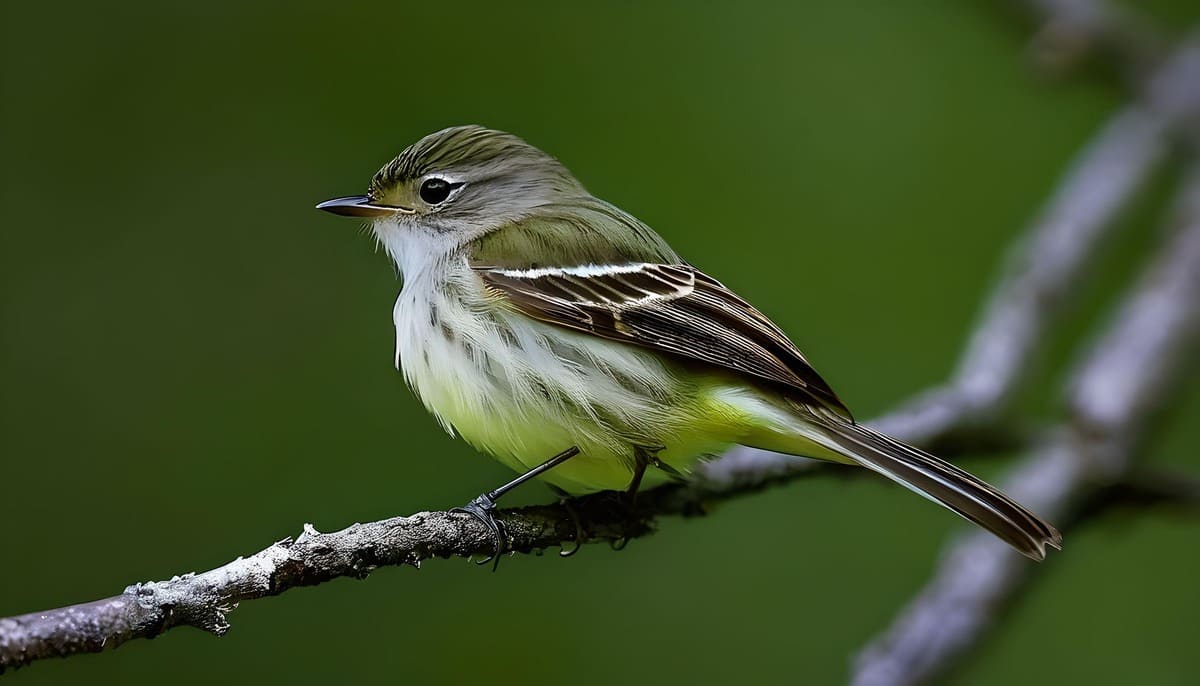
Predators and Threats of Acadian Flycatcher
While the Acadian Flycatcher may face threats from natural predators such as snakes and birds of prey, human-induced factors like habitat loss, deforestation, and climate change pose significant challenges to their population. Understanding these threats is crucial for effective conservation efforts.
Acadian Flycatcher Ecological Niche
The ecological niche of the Acadian Flycatcher encompasses its role as an insectivore, contributing to pest control in the forest ecosystem. Their habitat preferences influence the plant and animal species they interact with, shaping the overall biodiversity of their environment.
Impact on Local Ecosystems
The impact of Acadian Flycatchers on local ecosystems is multifaceted. By controlling insect populations, they help maintain ecological balance. Their nesting habits and foraging activities also influence the distribution of plants and other wildlife in their habitat.
Relationship with Other Species
The Acadian Flycatcher’s relationship with other species is interconnected within its ecosystem. They may interact with other bird species, competing for resources or sharing nesting spaces. Studying these relationships provides insights into the dynamics of avian communities.
Acadian Flycatcher Genome Sequencing and Conservation Genetics
Advancements in genomic research have led to the sequencing of the Acadian Flycatcher genome. Conservation genetics utilizes this information to assess genetic diversity and implement strategies for the species’ long-term survival.
Genome Sequencing Projects
Ongoing genome sequencing projects contribute to our understanding of the Flycatcher’s genetic makeup. These projects aid in identifying key genes related to adaptation, behavior, and resilience, guiding conservation efforts.
Conservation Genetics and Breeding Programs
Conservation genetics plays a vital role in developing breeding programs aimed at maintaining genetic diversity and preventing the decline of the Acadian Flycatcher population. These programs are essential for ensuring the species’ survival.
Acadian Flycatcher in Popular Culture and Mythology
The Acadian Flycatcher, with its distinctive appearance and melodious calls, might find its way into local folklore or mythology. Exploring its presence in popular culture provides a unique perspective on human perceptions of nature.

Cultural Significance
The cultural significance of the Acadian Flycatcher may extend beyond its ecological role. It could symbolize resilience, adaptability, or beauty in local cultures, contributing to a sense of connection between communities and their natural surroundings.
Acadian Flycatcher Tourism and Responsible Wildlife Watching
Tourism centered around the Flycatcher offers birdwatchers and nature enthusiasts the opportunity to appreciate these birds in their natural habitat. Responsible wildlife watching practices ensure minimal disturbance to the birds and their environment.
Balancing Tourism and Conservation
Balancing tourism and conservation efforts is crucial for preserving the habitat and well-being of the Acadian Flycatcher. Sustainable tourism practices and habitat protection measures play a pivotal role in achieving this balance.
Educational Initiatives for Tourists
Educational initiatives for tourists can enhance awareness about the importance of conserving the Acadian Flycatcher and its habitat. Interpretive programs, guided tours, and informational materials contribute to a greater understanding of the bird’s ecological significance.
Facts about Acadian Flycatcher
Here are some interesting facts about the Acadian Flycatcher:
- Scientific Classification: The Acadian Flycatcher belongs to the family Tyrannidae and is scientifically known as Empidonax virescens.
- Migratory Marvel: Flycatchers are neotropical migrants, undertaking long-distance journeys from their breeding grounds in North America to Central America during the winter months.
- Melodious Song: Recognized for its distinctive vocalizations, the Flycatcher produces a melodious “peet-sah” or “peet-see” call, which is an essential part of its communication, territory establishment, and courtship.
- Forest Dwellers: These birds prefer deciduous forests and wooded areas with a dense canopy, where they forage for insects amidst the treetops.
- Olive-Green Camouflage: The Acadian-Flycatcher’s plumage is predominantly olive-green, providing excellent camouflage among the leaves and branches of the forest.
- Nest Building Expertise: They construct cup-shaped nests with great precision, placing them in the vertical forks of tree branches. Both male and female actively participate in nest-building and caring for their chicks.
- Shared Parenting Responsibilities: During the breeding season, both parents take turns incubating the eggs and caring for the chicks upon hatching, showcasing a high level of parental cooperation.
- Small but Mighty: Measuring around 5 to 6 inches in length, the Acadian Flycatcher may be small, but its presence and song contribute significantly to the biodiversity of its habitat.
- Insectivorous Diet: Their primary diet consists of insects, and they employ a sit-and-wait strategy to catch their prey, demonstrating their prowess as skilled insect hunters.
- Conservation Concerns: While not currently listed as a threatened species, conservation efforts are crucial to ensuring the preservation of their preferred habitats and mitigating potential threats.
- Genomic Exploration: Advancements in genetic research have led to the sequencing of the Acadian-Flycatcher’s genome, providing insights into its evolutionary history and adaptations.
- Nocturnal Migration: Flycatchers are known to migrate at night, utilizing the cover of darkness to avoid predators and navigate their way to their wintering grounds.
Pros and Cons of Acadian Flycatcher
Here are some common Pros and Cons of Acadian Flycatcher:
| Pros of Acadian Flycatcher | Cons of Acadian Flycatcher |
|---|---|
| 1. Insect Control: Flycatchers play a vital role in controlling insect populations, contributing to the ecological balance in their habitat. | 1. Habitat Loss: Deforestation and habitat destruction pose a significant threat to Flycatchers, affecting their nesting and foraging areas. |
| 2. Melodious Calls: Their distinctive and melodious calls contribute to the natural symphony of the forest, adding to the overall biodiversity. | 2. Vulnerability to Predators: Like many birds, Acadian-Flycatchers face threats from natural predators such as snakes, birds of prey, and other animals. |
| 3. Neotropical Migration: Their impressive long-distance migration to Central America helps maintain connectivity between ecosystems and supports genetic diversity. | 3. Climate Change: Changes in climate patterns can affect the availability of food resources and impact the timing of migration, posing challenges to their survival. |
| 4. Ecotourism Opportunities: Acadian-Flycatchers provide opportunities for responsible ecotourism, allowing birdwatchers to appreciate their beauty in natural settings. | 4. Human Disturbance: Overly enthusiastic birdwatching or human presence near nesting areas can disturb breeding pairs and negatively impact their reproductive success. |
| 5. Nest-Building Behavior: The meticulous construction of cup-shaped nests reflects their adaptability and contributes to the overall biodiversity of their habitat. | 5. Limited Genetic Diversity: Small populations and specific habitat requirements may lead to limited genetic diversity, making them more susceptible to diseases and environmental changes. |
| 6. Shared Parenting: Both male and female Acadian Flycatchers actively participate in nest-building and parenting, showcasing cooperative behaviors. | 6. Light Pollution: Urbanization and excessive artificial lighting can disrupt their nocturnal migration patterns and navigation. |
| 7. Indicator Species: Changes in the population and behavior of Flycatchers can serve as indicators of broader environmental health and ecosystem changes. | 7. Noise Pollution: Excessive noise from human activities, such as construction, can interfere with their ability to communicate and defend territory. |
| 8. Genetic Research Value: Genome sequencing projects provide valuable insights into their evolutionary history, aiding conservation efforts. | 8. Pesticide Exposure: The use of pesticides can harm Flycatchers indirectly by reducing insect prey availability or directly through toxicity. |
| 9. Educational Value: Studying Acadian-Flycatchers contributes to educational initiatives, raising awareness about the importance of wildlife conservation. | 9. Potential Nest Parasitism: Cowbirds may parasitize Acadian-Flycatcher nests, placing their own eggs in the nest and potentially harming the host chicks. |
| 10. Cultural Significance: In some cultures, these birds may hold cultural significance, fostering a sense of connection between communities and their natural environment. | 10. Limited Adaptability: Their reliance on specific forested habitats makes them vulnerable to changes in land use and habitat fragmentation. |
Acadian Flycatcher Relationship with Humans
The relationship between the Acadian Flycatcher (Empidonax virescens) and humans is primarily one of coexistence within the broader context of nature. Here are several aspects of their relationship with humans:
- Observation and Appreciation: Birdwatchers and nature enthusiasts appreciate the Acadian-Flycatcher for its unique features, including its melodious calls and olive-green plumage. Observing these birds in their natural habitat contributes to a greater understanding and appreciation of nature.
- Ecotourism Opportunities: The presence of Flycatchers in certain areas provides opportunities for responsible ecotourism. Birdwatchers may travel to specific locations to observe and appreciate these birds, contributing to local economies and promoting conservation awareness.
- Conservation Concerns: Conservationists and researchers study Acadian Flycatchers to better understand their behaviors, migration patterns, and overall ecology. This research contributes to conservation initiatives aimed at preserving their habitats and ensuring their long-term survival.
- Educational Initiatives: The Acadian Flycatcher serves as an educational tool to raise awareness about the importance of wildlife conservation. Educational programs, workshops, and interpretive materials help inform the public about the role of these birds in maintaining ecological balance.
- Challenges and Threats: Human activities, such as habitat destruction, deforestation, and climate change, pose challenges and threats to the Flycatcher. Conservation efforts often involve mitigating these impacts and finding ways for humans and wildlife to coexist sustainably.
- Legal Protections: Legal protections are in place to prevent the disturbance, capture, or keeping of Acadian Flycatchers without proper permits. These legal measures aim to safeguard the well-being of the birds and their habitats.
- Habitat Preservation: Humans play a critical role in habitat preservation. Efforts to protect and restore wooded areas, especially those with a dense canopy, contribute directly to the well-being of Acadian-Flycatchers and other wildlife species.
- Citizen Science Participation: Citizen scientists often contribute valuable data to ornithological research by participating in bird monitoring programs. This collaboration between researchers and the public enhances our collective understanding of the behavior and distribution of Acadian Flycatchers.
- Balancing Tourism and Conservation: Responsible tourism practices, such as birdwatching with minimal disturbance and adhering to ethical guidelines, help balance the interests of tourism with the conservation needs of Acadian-Flycatchers and their habitats.
- Cultural Significance: In some cultures, birds like the Flycatcher may hold cultural or symbolic significance. Folklore, art, and literature may incorporate these birds, fostering a connection between humans and nature.

Health Issues of Acadian Flycatcher
While the Acadian Flycatcher (Empidonax virescens) is not subject to health issues specific to domesticated animals, its well-being is closely tied to the health of its natural environment. Key considerations for the health of Flycatchers include:
- Habitat Loss: Deforestation, urbanization, and habitat destruction are significant threats to Acadian-Flycatchers. Loss of suitable habitats can lead to declines in population and reproductive success.
- Climate Change: Changes in climate patterns can impact the availability of food resources, alter migration patterns, and affect the overall health of Flycatchers and their ecosystems.
- Pesticide Exposure: The use of pesticides can harm Acadian Flycatchers indirectly by reducing insect prey availability or directly through toxicity. As insectivores, these birds rely on a healthy insect population.
- Nest Parasitism: Cowbirds may parasitize Flycatcher nests, placing their own eggs in the nest and potentially harming the host chicks. This can impact the reproductive success of Acadian-Flycatchers.
- Human Disturbance: Excessive human presence near nesting areas, particularly during breeding seasons, can disturb breeding pairs, leading to stress and reduced reproductive success.
Conservation Status of Acadian Flycatcher
The conservation status of the Acadian Flycatcher is categorized as “Least Concern” on the International Union for Conservation of Nature (IUCN) Red List. This classification indicates that the species is not currently facing imminent threats of extinction.
However, it’s important to note that conservation statuses are subject to change as new information becomes available. The main threats to the Flycatcher’s conservation include habitat loss, climate change, and other human-induced disturbances. Conservation efforts are essential to ensuring the continued well-being of this species. Such efforts may include:
- Habitat Protection: Preserving and protecting the wooded habitats preferred by Flycatchers is crucial for maintaining healthy populations.
- Research and Monitoring: Continued research on the ecology, behavior, and population trends of Acadian Flycatchers helps inform conservation strategies and management practices.
- Education and Awareness: Increasing public awareness about the importance of preserving natural habitats and the role of Acadian Flycatchers in ecosystem health fosters a sense of responsibility and encourages conservation efforts.
- Policy and Legislation: Implementing and enforcing policies and legislation that protect wildlife habitats and regulate activities that may harm Flycatchers are fundamental to their conservation.
Threats and Challenges
Threats and Challenges:
- Habitat Loss: Deforestation and land development are major threats, leading to a decline in suitable nesting and foraging sites.
- Climate Change: Altered weather patterns and habitat disruption due to climate change can affect the availability of food sources and nesting locations.
- Nest Parasitism: Cowbirds parasitizing Acadian Flycatcher nests can impact reproductive success.
- Human Disturbance: Increased human presence and activities near nesting areas can disrupt breeding pairs and nesting success.
Conservation Strategies and Technological Innovations
Conservation Strategies and Technological Innovations:
- Habitat Protection: Preserving and restoring wooded habitats is critical for the long-term survival of Acadian Flycatchers.
- Research and Monitoring: Technological innovations, including GPS tracking and remote sensing, assist researchers in monitoring Acadian Flycatcher populations and understanding their movements.
- Community Engagement: Involving local communities in conservation efforts fosters a sense of responsibility and ensures sustainable practices.
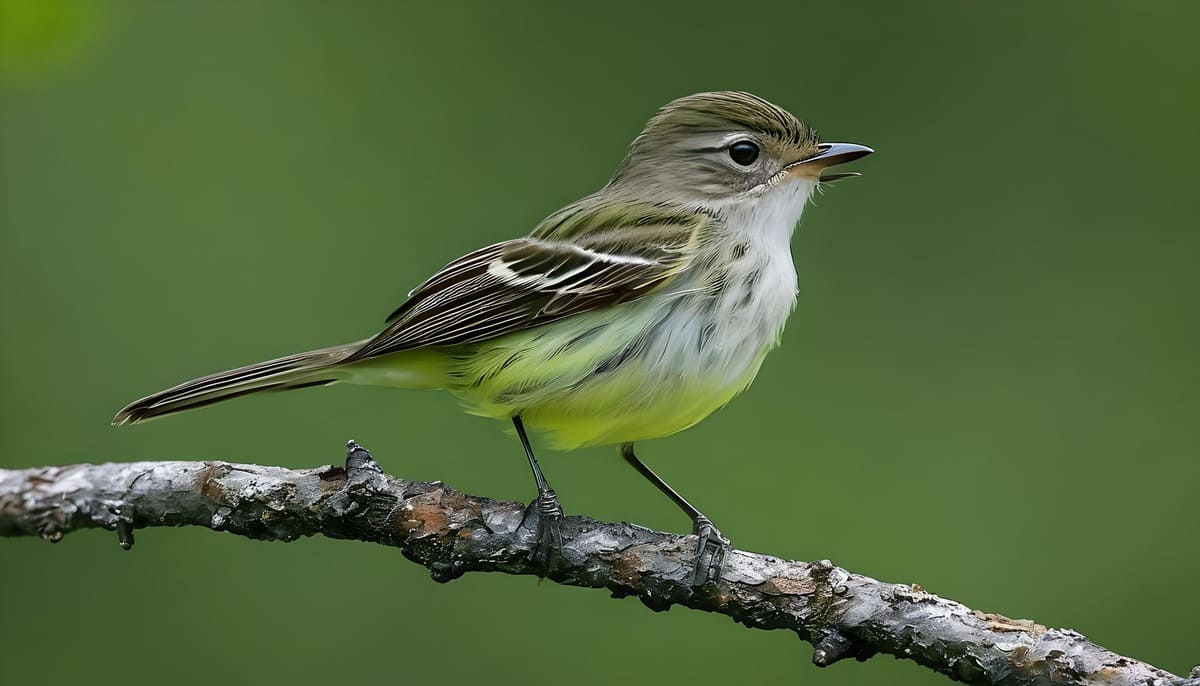
Technological Solutions for Monitoring Acadian Flycatcher Populations
Technological Solutions for Monitoring Acadian Flycatcher Populations:
- GPS Tracking: Small, lightweight GPS devices attached to birds can provide valuable information on their migratory routes and behavior.
- Acoustic Monitoring: Automated recording devices can capture and analyze Acadian Flycatcher vocalizations for population monitoring.
- Remote Sensing: Satellite and drone technology can assist in mapping and monitoring forested habitats, aiding in habitat management.
Community-Based Conservation Initiatives
Community-Based Conservation Initiatives:
- Education and Outreach: Community engagement through educational programs raises awareness about the importance of preserving natural habitats.
- Citizen Science: Involving local communities in data collection and monitoring initiatives enhances the understanding of Acadian Flycatcher populations.
Acadian Flycatcher Lifespan
The Acadian Flycatcher, like many small passerines, typically has a lifespan ranging from 3 to 5 years. It’s important to note that the lifespan of individual birds can be influenced by various factors, including predation, environmental conditions, and human-related threats.
Physical Description of Acadian Flycatcher
The Acadian Flycatcher (Empidonax virescens) is a small songbird with distinct features that contribute to its unique physical appearance. Here’s a detailed description of its physical characteristics:
- Size: The Acadian Flycatcher is a small bird, measuring approximately 5 to 6 inches (12.7 to 15.2 centimeters) in length.
- Plumage: The plumage of the Acadian Flycatcher is predominantly olive-green, providing excellent camouflage among the leaves and branches of its forested habitat. The coloration helps the bird blend seamlessly into the foliage.
- Head: The head is relatively plain, featuring the same olive-green color as the rest of the body. The crown may be slightly darker than the rest of the head.
- Eyering: One of the distinctive features of the Acadian Flycatcher is its prominent eyering. This eyering is a thin, incomplete circle of a lighter color around the eye, adding a subtle yet noticeable accent.
- Bill: The bill is relatively short and slightly hooked, reflecting its insectivorous diet. The shape of the bill aids in catching flying insects, a primary source of food for the Acadian Flycatcher.
- Wings and Tail: The wings and tail are often similar in color to the body, with a subtle contrast. The wings are relatively short and pointed, contributing to the bird’s agile flight.
- Underparts: The underparts, including the throat and breast, share the same olive-green hue as the upperparts. The coloration is consistent throughout the body.
- Legs and Feet: The legs and feet are typically small and adapted for perching. They are not particularly conspicuous, often blending with the general coloration of the bird.
- Sexual Dimorphism: In terms of plumage, male and female Acadian Flycatchers look similar. They share the same olive-green coloration, and external differences are minimal.
- Juveniles: Juvenile Acadian Flycatchers have a similar appearance to adults but may exhibit a slightly duller plumage. Over time, as they mature, their coloration becomes more vibrant.
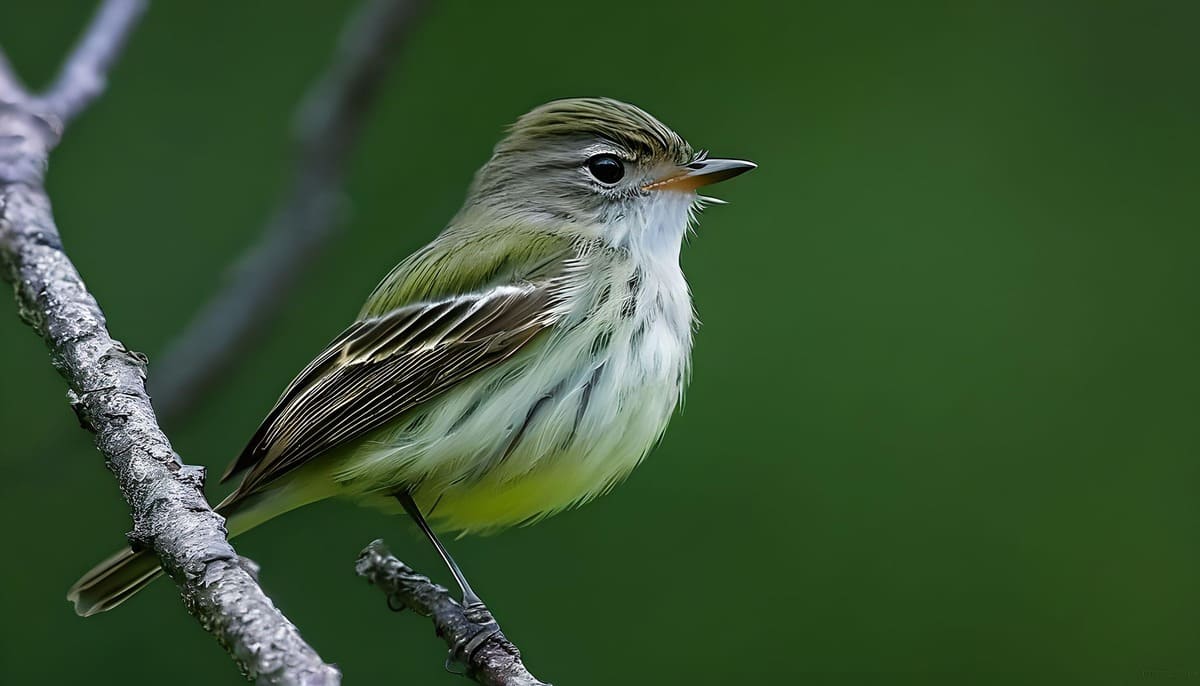
Diet and Prey of of Acadian Flycatcher
The Acadian Flycatcher (Empidonax virescens) is an insectivorous bird with a diet primarily consisting of various flying insects. Here’s a closer look at its diet and prey:
- Insectivorous Diet:
- The Acadian Flycatcher is exclusively insectivorous, meaning it relies on insects as its main source of food. Its diet consists of a wide variety of flying insects.
- Foraging Technique:
- These birds use a sit-and-wait foraging strategy. They perch in the understory or on lower branches, closely watching their surroundings. When an insect is spotted, they quickly sally forth to catch it mid-air.
- Prey Types:
- The specific types of insects the Acadian Flycatcher preys upon can include various flying insects such as moths, flies, beetles, mosquitoes, and other small invertebrates.
- Nocturnal Insect Catching:
- While primarily diurnal (active during the day), Acadian Flycatchers may also catch nocturnal insects during their nighttime migrations. They take advantage of the abundant insect activity during the evening.
- Hunting Habitat:
- The bird’s preference for deciduous forests and wooded areas with a dense canopy provides an ideal hunting ground. The foliage provides cover for the flycatcher as it waits for prey.
- Adaptations for Insect Hunting:
- The Acadian Flycatcher’s slightly hooked bill and agile flight help it capture insects in mid-air. The bird may also glean insects from leaves or branches while perched.
- Parental Provisioning:
- During the breeding season, when raising chicks, both male and female Acadian Flycatchers contribute to feeding the young by bringing a variety of insects to the nest.
- Ecological Role:
- As insectivores, Acadian Flycatchers play an essential role in controlling insect populations within their habitat. They contribute to the balance of the ecosystem by helping to regulate insect numbers.
Acadian Flycatcher Overview and Care Video
Conclusion:
The Acadian Flycatcher, a small insectivorous bird, is recognized for its olive-green plumage and melodious calls. Thriving in deciduous forests, it plays a vital role in controlling insect populations. Despite facing threats like habitat loss, climate change, and human disturbance, conservation efforts, including habitat preservation and community engagement, are crucial for its survival. Ongoing research and technological innovations contribute to our understanding and protection of these birds, highlighting the importance of conservation in maintaining biodiversity and ecological balance.
Frequently Asked Questions on Acadian Flycatchers:
-
What is the Acadian Flycatcher?
The Acadian Flycatcher (Empidonax virescens) is a small songbird known for its olive-green plumage, distinctive vocalizations, and insectivorous diet. It’s commonly found in deciduous forests.
-
Where is the Acadian Flycatcher’s habitat?
Acadian Flycatchers prefer wooded areas with a dense canopy, including deciduous forests. They inhabit regions in the southeastern United States and the Great Lakes.
-
What does the Acadian Flycatcher eat?
The Acadian Flycatcher primarily feeds on flying insects such as moths, flies, beetles, and mosquitoes. Its diet is exclusively insectivorous.
-
How does the Acadian Flycatcher catch its prey?
Using a sit-and-wait strategy, the Acadian Flycatcher perches and observes its surroundings. When it spots an insect, it quickly sallies forth to catch it mid-air, showcasing agility in flight.
-
What is the conservation status of the Acadian Flycatcher?
As of the last update, the Acadian Flycatcher is categorized as “Least Concern” on the IUCN Red List, indicating it is not facing immediate threats of extinction. However, habitat loss and other factors require ongoing conservation efforts.
-
How does the Acadian Flycatcher contribute to the ecosystem?
Acadian Flycatchers play a crucial role in controlling insect populations, contributing to the ecological balance of their habitat. They help regulate insect numbers, acting as natural pest controllers.
-
What are the threats to Acadian Flycatchers?
Threats include habitat loss due to deforestation, climate change impacting their environment, nest parasitism by cowbirds, and disturbances from human activities.
-
Are Acadian Flycatchers migratory?
Yes, Acadian Flycatchers are neotropical migrants, undertaking long-distance migrations from their breeding grounds in North America to Central America during the winter months.
-
How can I contribute to Acadian Flycatcher conservation?
You can contribute by supporting habitat preservation initiatives, participating in responsible birdwatching, and engaging in educational programs that raise awareness about the importance of their conservation.
-
What is the lifespan of an Acadian Flycatcher?
The lifespan of Acadian Flycatchers typically ranges from 3 to 5 years. Factors such as predation, environmental conditions, and human-related threats can influence their lifespan.
Recommended –




